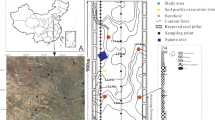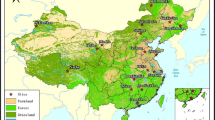Abstract
Soil moisture is a critical parameter for land reclamation and ecological restoration in mining subsidence areas. However, limited research has been conducted into the impact of subsidence on soil moisture in semi-arid areas. In this study, the subsidence and soil moisture of four coal seams (4101 and 4102 coal seams are 2-year and 1-year subsidence area, 4103 and 4104 coal seams are just after mining and ready for mining) in semi-arid region were monitored for a year. A soil moisture retrieval method suitable for semi-arid mining areas was improved. The results showed that the reduced Bias, MRE and RMSE difference between satellite and in situ soil moisture to 0.129, 0.0851 and 0.0219, respectively, which demonstrated the reliability of the proposed soil moisture retrieval method in the semi-arid mining areas. We found that there was ecological self-restoration, the degree of spatial variability of soil moisture was gradually weaker with the increased subsidence time by comparing coal seams with different subsidence time. The average value of soil moisture in 4103 and 4104 coal seams decreased by 0.20% and 1.89%, respectively, whereas the coefficient of variation increased by 13.99% and 10.45%, respectively. Window cross-correlation analysis shows underground mining activities have a lag effect. The mean time lag between subsidence and the soil moisture response varied 90 days after the subsidence occurred. But, about 120 days after the end of mining, soil moisture gradually recovers. All these results indicated repair of land cracks in time at subsidence edge can prevent the decline of soil moisture.









Similar content being viewed by others
Data availability
The data supporting the findings of this study are available from the corresponding author upon reasonable request.
References
Bai L, Wang Y, Zhang K et al (2022) Spatial variability of soil moisture in a mining subsidence area of northwest China. Int J Coal Sci Technol 9:64. https://doi.org/10.1007/s40789-022-00517-w
Brown L, Chen JM, Leblanc SG, Cihlar J (2000) A shortwave infrared modification to the simple ratio for LAI retrieval in boreal forests: an image and model analysis. Remote Sens Environ 71:16–25. https://doi.org/10.1016/S0034-4257(99)00035-8
Cao Y, Zhu H, Bi R, Jin Y (2022) Spatial and temporal characteristics of surface soil moisture in a disturbed coal mining area of Chinese Loess Plateau. Plos one 17(5):265–317. https://doi.org/10.1371/journal.pone.0265837
Chen S, Zhao K, Jiang T et al (2018) Predicting surface roughness and moisture of bare soils using multiband spectral reflectance under field conditions. Chin Geogr Sci 28:986–997. https://doi.org/10.1007/s11769-018-1007-x
Cui X, Peng S, Lines LR et al (2019) Understanding the capability of an ecosystem nature-restoration in coal mined area. Sci Rep 9:19690. https://doi.org/10.1038/s41598-019-55935-9
Gao B (1996) NDWI—a normalized difference water index for remote sensing of vegetation liquid water from space. Remote Sens Environ 58:257–266. https://doi.org/10.1016/S0034-4257(96)00067-3
Gao X, Wu P, Zhao X et al (2013) Estimating the spatial means and variability of root-zone soil moisture in gullies using measurements from nearby uplands. J Hydrol 476:28–41. https://doi.org/10.1016/j.jhydrol.2012.10.030
Herrmann I, Karnieli A, Bonfil DJ et al (2010) SWIR-based spectral indices for assessing nitrogen content in potato fields. Int J Remote Sens 31:5127–5143. https://doi.org/10.1080/01431160903283892
Hu Z, Fu Y, Xiao W et al (2015) Ecological restoration plan for abandoned underground coal mine site in Eastern China. Int J Min Reclam Environ 29:316–330. https://doi.org/10.1080/17480930.2014.1000645
Huang Y, Chang Q, Li Z (2018) Land use change impacts on the amount and quality of recharge water in the loess tablelands of China. Sci Total Environ 628–629:443–452. https://doi.org/10.1016/j.scitotenv.2018.02.076
Huete A, Didan K, Miura T et al (2002) Overview of the radiometric and biophysical performance of the MODIS vegetation indices. Remote Sens Environ 83:195–213. https://doi.org/10.1016/S0034-4257(02)00096-2
Lu Y, Liu X, Heitman J et al (2016) Determining soil bulk density with thermo-time domain reflectometry: a thermal conductivity-based approach. Soil Sci Soc Am J 80:48–54. https://doi.org/10.2136/SSSAJ2015.08.0315
Ma T, Han L, Liu Q (2021) Retrieving the soil moisture in bare farmland areas using a modified Dubois model. Front Earth Sci 9:735958. https://doi.org/10.3389/feart.2021.735958
Mason TJ, Krogh M, Popovic GC et al (2021) Persistent effects of underground longwall coal mining on freshwater wetland hydrology. Sci Total Environ 772:144772. https://doi.org/10.1016/j.scitotenv.2020.144772
Ren H, Feng G (2015) Are soil-adjusted vegetation indices better than soil-unadjusted vegetation indices for above-ground green biomass estimation in arid and semi-arid grasslands? Grass Forage Sci 70:611–619. https://doi.org/10.1111/gfs.12152
Shi J, Wang JR, Hsu AY et al (1997) Estimation of bare surface soil moisture and surface roughness parameter using L-band SAR image data. IEEE Trans Geosci Remote Sens 35:1254–1266
Shi W, Li K, Yu S et al (2021) Analysis on subsidence law of bedrock and ultrathick loose layer caused by coal mining. Geofluids 2021:e8849955. https://doi.org/10.1155/2021/8849955
Sims DA, Gamon JA (2002) Relationships between leaf pigment content and spectral reflectance across a wide range of species, leaf structures and developmental stages. Remote Sens Environ 81:337–354. https://doi.org/10.1016/S0034-4257(02)00010-X
Tucker CJ (1979) Red and photographic infrared linear combinations for monitoring vegetation. Remote Sens Environ 8:127–150. https://doi.org/10.1016/0034-4257(79)90013-0
Wang Y, Magliulo V, Yan W, Shangguan Z (2019) Assessing land surface drying and wetting trends with a normalized soil water index on the Loess Plateau in 2001–2016. Sci Total Environ 676:120–130. https://doi.org/10.1016/j.scitotenv.2019.04.195
Wang K, Li J, Jin Z (2022) Influence of the primary key stratum on surface subsidence during longwall mining. Sustainability 14:15027. https://doi.org/10.3390/su142215027
Xing X, Ma X (2019) Analysis of cracking potential and modification of soil-water characteristic curve by adding wheat residues. Soil Sci Soc Am J 83:1299–1308. https://doi.org/10.2136/sssaj2018.12.0491
Yang D, Bian Z (2022) Comparison of the disturbance of soil physical quality indices between different underground mining stages in semi-arid regions of Western China. Environ Earth Sci 81:354. https://doi.org/10.1007/s12665-022-10486-7
Yang D, Bian Z, Lei S (2016) Impact on soil physical qualities by the subsidence of coal mining: a case study in Western China. Environ Earth Sci 75:652. https://doi.org/10.1007/s12665-016-5439-2
Yi Z, Liu M, Liu X et al (2021) Long-term Landsat monitoring of mining subsidence based on spatiotemporal variations in soil moisture: a case study of Shanxi Province, China. Int J Appl Earth Observ Geoinf 102:102447. https://doi.org/10.1016/j.jag.2021.102447
Yilmaz MT, Hunt ER, Jackson TJ (2008) Remote sensing of vegetation water content from equivalent water thickness using satellite imagery. Remote Sens Environ 112:2514–2522. https://doi.org/10.1016/j.rse.2007.11.014
Yu F, Zhao Y (2011) A new semi-empirical model for soil moisture content retrieval by ASAR and TM data in vegetation-covered areas. Sci China Earth Sci 54:1955–1964. https://doi.org/10.1007/s11430-011-4204-3
Yu B, Liu G, Liu Q et al (2019) Effects of topographic domain and land use on spatial variability of deep soil moisture in the semi-arid Loess Plateau of China. Hydrol Process 50:1281–1292. https://doi.org/10.2166/nh.2019.221
Yu Y, Ma L, Zhang D (2020) Characteristics of roof ground subsidence while applying a continuous excavation continuous backfill method in longwall mining. Energies 13:95. https://doi.org/10.3390/en13010095
Yuan K, Ni W, Lu X, Wang X (2021) Permeability characteristics and structural evolution of compacted loess under different dry densities and wetting-drying cycles. Plos one 16:232–251. https://doi.org/10.1371/journal.pone.0253508
Zhang K, Yang K, Wu X et al (2022) Effects of underground coal mining on soil spatial water content distribution and plant growth type in Northwest China. ACS Omega 7:18688–18698. https://doi.org/10.1021/acsomega.2c01369
Zhen Q, Zheng J, Zhang X, Shao M (2019) Changes of solute transport characteristics in soil profile after mining at an opencast coal mine site on the Loess Plateau, China. Sci Total Environ 665:142–152. https://doi.org/10.1016/j.scitotenv.2019.02.035
Zhou D-W, Wu K, Cheng G-L, Li L (2015) Mechanism of mining subsidence in coal mining area with thick alluvium soil in China. Arab J Geosci 8:1855–1867. https://doi.org/10.1007/s12517-014-1382-2
Zribi M, Gorrab A, Baghdadi N (2014) A new soil roughness parameter for the modelling of radar backscattering over bare soil. Remote Sens Environ 152:62–73. https://doi.org/10.1016/j.rse.2014.05.009
ZylJ V (1993) The effects of topography on the radar scattering from vegetated areas. IEEE Trans Geosci Remote Sens 31:153–160
Acknowledgements
The study was supported by the National Natural Science Foundation of China (No. 52274168). We acknowledge all researchers who contributed to monitor long-term subsidence and soil moisture. We also thank Shaanxi Binchang Mining Group Co., Ltd. for providing us with detailed mining data.
Funding
The National Natural Science Foundation of China (No. 52274168).
Author information
Authors and Affiliations
Contributions
All authors contributed to the study’s conception and design. Material preparation, data collection and analysis were performed by TM, FT, JT, QY and XJ. The first draft of the manuscript was written by TM, and all authors commented on previous versions of the manuscript. All authors read and approved the final manuscript.
Corresponding author
Ethics declarations
Conflict of interest
The authors declare no competing interests.
Additional information
Publisher's Note
Springer Nature remains neutral with regard to jurisdictional claims in published maps and institutional affiliations.
Appendix A
Appendix A
Table 3 is the detailed image data used in the paper. Table 4 is the parameter values of the soil moisture inversion model. Equations A1–A4 are soil moisture inversion accuracy parameters.
Rights and permissions
Springer Nature or its licensor (e.g. a society or other partner) holds exclusive rights to this article under a publishing agreement with the author(s) or other rightsholder(s); author self-archiving of the accepted manuscript version of this article is solely governed by the terms of such publishing agreement and applicable law.
About this article
Cite this article
Ma, T., Tang, F., Tang, J. et al. Effect of coal mining on soil moisture in the semi-arid area based on an improved remote sensing estimation approach. Environ Earth Sci 82, 545 (2023). https://doi.org/10.1007/s12665-023-11245-y
Received:
Accepted:
Published:
DOI: https://doi.org/10.1007/s12665-023-11245-y




